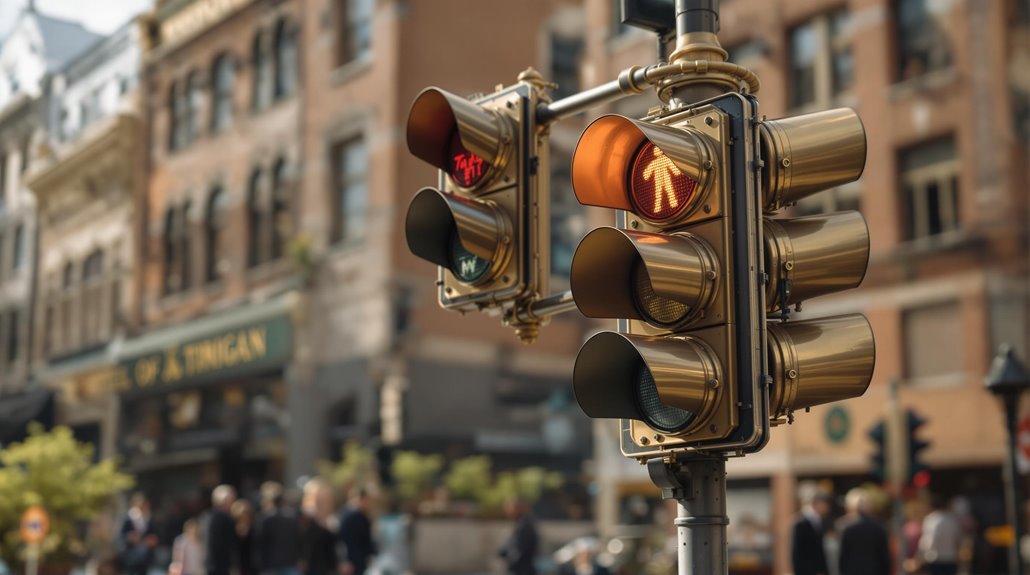Garrett Morgan’s 3-Way Traffic Light: The Accident That Forced Cities to Listen
Picture yourself at a chaotic city intersection in 1923, where horses and automobiles dance a dangerous waltz through crossing paths. You've probably never thought twice about that yellow light that gives you precious seconds to slow down, but there's a haunting story behind its creation. When Garrett Morgan witnessed a devastating collision between a car and horse carriage, he didn't just shake his head in dismay – he changed the future of urban transportation forever.
The Early Struggles of a Determined Inventor

Despite having only six years of formal education, Garrett Morgan emerged as one of America's most innovative inventors through sheer determination and entrepreneurial spirit. Born to former slaves in Paris, Kentucky, he faced early challenges that would have deterred many others.
After moving to Cincinnati at 14, he hired a tutor to continue his education while working, showing his commitment to self-improvement.
When Morgan relocated to Cleveland in 1895, he transformed himself from a floor sweeper into a successful businessman within a decade. His career began when he started as a sewing machine mechanic, learning the skills that would later inspire his innovations.
You'll find his entrepreneurial spirit evident in how he established a thriving sewing repair shop, launched a clothing business employing over 30 people, and founded the G.A. Morgan Hair Refining Company.
Even facing racial discrimination, he cleverly adapted by using white actors to demonstrate his inventions. His determination for equality led him to establish one of the first black fraternities at Cleveland's Western Reserve University.
A Deadly Intersection Changes Everything
While driving with his sons in 1923, Garrett Morgan witnessed a horrific collision that would forever change his approach to invention.
At a chaotic intersection, he watched helplessly as a car struck a horse-drawn carriage, throwing a young girl from her seat and fatally injuring the horse.
The accident highlighted everything wrong with the era's traffic control systems.
You'd find busy streets filled with an unpredictable mix of automobiles, carriages, cyclists, and pedestrians, all maneuvering without proper intersection safety measures.
The basic red and green lights of the time proved insufficient for managing the growing traffic complexities.
His innovative solution would later be purchased by General Electric for $40,000.
Despite newspapers' attempts at traffic education, the existing two-position signals proved dangerously inadequate, especially when operators grew tired or weren't present at night.
Morgan knew he couldn't stand idle after what he'd seen.
This devastating incident drove him to develop a solution that would prevent similar tragedies at intersections.
Engineering a Safer Solution
After witnessing the tragic accident, Morgan channeled his inventive talents into creating a revolutionary traffic signal design. His engineering advancements centered on a T-shaped pole with three distinct positions, introducing an innovative "caution" signal when all arms were raised upright.
You'll notice how Morgan's design prioritized traffic safety through several key features. The signal could be adjusted to half-mast during low traffic periods, while a hand-crank allowed for manual operation with greater precision than police officers at intersections. His patent in 1923 set a new standard for traffic management.
His most significant improvement was the third "caution" position, which cleared intersections before changing traffic directions. This simple yet effective solution reduced collisions during signal shifts and accounted for varying traffic density. The high number of accidents before standardization made this innovation particularly crucial for urban safety.
The design proved so successful that General Electric purchased the rights for $40,000.
The T-Shaped Innovation That Saved Lives
As Morgan's innovative T-shaped traffic signal hit the streets in 1923, it quickly proved to be a game-changer for road safety.
You'd find his design revolutionizing signal technology with three distinct positions: Stop, Go, and an all-directional stop that introduced the vital warning phase we recognize today as the yellow light.
What made this invention truly remarkable was its adaptability. You could adjust it based on traffic density, and it even featured a half-mast position for low-traffic periods. As a prolific Black inventor, Morgan's ingenuity earned him the nickname "Black Edison" among his peers.
The warning phase gave drivers time to prepare for stops, preventing the abrupt halts that often caused accidents. His experience as a car owner in Cleveland had given him firsthand insight into the dangers of unregulated intersections. General Electric recognized the invention's potential, purchasing the rights for $40,000.
Morgan's principles of traffic safety continue to influence the over 300,000 signalized intersections across America today.
From Cleveland Streets to National Recognition

Morgan's journey to national recognition began with a horrific car crash he witnessed on Cleveland's bustling streets in 1923.
After seeing the devastating effects of inadequate traffic control, he patented his innovative three-position signal that same year. The revolutionary design featured three traffic settings, providing a much safer way to control traffic flow. His invention caught the attention of General Electric, who purchased the rights for $40,000 – a substantial sum equivalent to $733,000 today.
As Cleveland traffic improved with his system, Morgan's national legacy grew steadily. You'll find his influence in the over 300,000 signalized intersections across America today.
His contributions earned him numerous accolades, including a U.S. government citation and induction into the National Inventors Hall of Fame in 2005.
The Garrett Morgan School of Engineering and Innovation now stands as a reflection of his enduring impact on American road safety.











